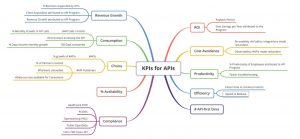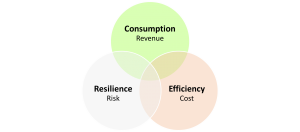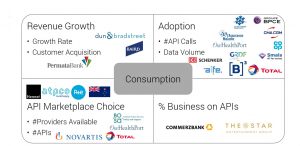In Part One of our blog series, KPIs for APIs, we discussed how KPIs for APIs (Key Performance Indicators) are used to develop your platform to demonstrate the importance of your APIs to your team and stakeholders. Today, we go deeper to show what KPIs for APIs more uses and examples are being used in great detail.
Ask and you shall receive…
We asked over 500 of our Axway customers to see what KPIs they were using and what they would be happy to share. We gathered different results as each company has distinctive priorities to reach on their digital journey.
By grouping them, we were able to come up with 10 different categories of KPIs:

- Revenue growth
- Consumption of revenue is what drives revenue growth
- Choice
- Availability
- Compliance
- ROI
- Cost Avoidance
- Productivity
- Efficiency to drive costs down
- Developers in the API team
Since 10 categories are too much for us to use in the field, I suggest we gather these KPIs in just three categories.
Those categories being already the obsession of our key stakeholders:
- Revenue
- Cost
- Risk
We can also remember in more engaging terms:
- Consumption
- Efficiency
- Resilience

Consumption KPIs
Without further ado, let’s dive into the first category. What KPIs should you use to talk about the Consumption topic?
- Revenue growth. Companies can demonstrate how much revenue they have generated thanks to APIs. Or sometimes, Companies track revenue growth thanks to their API program. Or with Customer Acquisition, they track the number of customers you have acquired thanks to your API program.
- Adoption is another factor of consumption KPI. This sort of tracking comes with API calls and data volume to track your APIs.
“Customer Acquisition KPI equals the Lifetime value of customer times the number of customers in an API program.”
- Marketplace Choice. How much choice do you provide to the customers for a platform? The more the better! You can also correlate the growth rate of KPI times the amount of revenue generated by Y number of partners. This becomes correlated with the average number of calls needed for partners to transact.
- Percentage of business on APIs. Much business gets conducted over an API program. Sometimes traditional businesses get over 80% of revenue supported by APIs, that is thanks to their API Program they have quintupled (x5) their business!

Now let’s have a look at some real examples:
- Revenue Growth. The company BAIRD, a wealth management company in the USA were able to track its growth rate at 50% thanks to the API program. Another KPI for revenue growth is customer acquisition: PermataBank in Indonesia was able to quadruple (x4) their customer acquisition. Thanks to APIs, more customers are joining or opening accounts with PermataBank, a huge success to be reported to shareholders.
- On the other end, what we typically see is companies reporting on adoption metrics. They can be the number of API calls or the volume of data exchange with their customers.
An API call is good at tracking the trend of adoption of your program and it’s not necessarily something that the shareholder would understand as creating value for the company.
That is why some API teams have taken the time to establish a link between their Customer Lifetime Value (CLV), and the number of calls for that customer. The more they engage with your API, the more they get value, the more you get value!
This also applies to growth rates from channels: once you’ve linked how much revenue is generated by how many partners are available in your ecosystem, along with how many calls are necessary on average for partners to transact, then you’ll be able to report on the growth rate via usage of your partner API.
- Marketplace choice. A third family of Consumption metrics is the choice your platform provide to your community.
What can people do on your platform? For example, the company Henner, a medical coverage company that covers 200 countries with 49,000 health partners and provides services to 10,000 companies. They were able to provide the choice of all those health partners with their API program.
KPIs for APIs more uses and examples
Another example is ATPCO, a company in the airline industry, this company is the leader in the distribution and monetization, and pricing of air tickets.
They provided the choice of up to 220 distribution channels for airline tickets to their customers.
RTE which is the leader in Power Distribution across Europe needed to interface with 1,300 stakeholders to track as part of their API program. This allowed them to achieve their goal of interfacing with everyone.
When it comes to choice and the number of APIs or providers available, if you cannot link this choice with citizen choice or revenue growth, then most of your stakeholders won’t understand the value of the efforts you are making to provide them with better opportunities.
The fourth area of consumption
Finally, the fourth area of consumption that we can see in KPIs is how much of the business is being conducted by the company with APIs?
In the case of the German bank, Commerzbank, and The Star Entertainment Group, an entertainment group as well as a casino; in both cases, they were able to measure the percentage of the business with APIs.
Up to 80% of revenue for Star Entertainment originates from their API program. This means that a properly conducted digital program leading to an open platform can quintuple (x5) your revenue!
In Part Three of our blog series, we will explore more details about KPIs.
Learn more about what metrics are and how to measure them.

Follow us on social